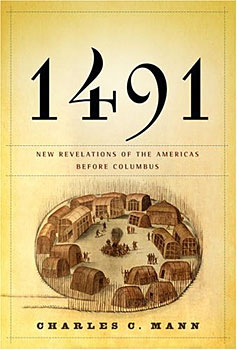| book recommendation

1491:
New Revelations of the Americas Before Columbus
by Charles C. Mann
This book will open your eyes. From Amazon:
|
1491 is not so much the story of a year, as of what that year stands for: the long-debated (and often-dismissed) question of what human civilization in the Americas was like before the Europeans crashed the party. The history books most Americans were (and still are) raised on describe the continents before Columbus as a vast, underused territory, sparsely populated by primitives whose cultures would inevitably bow before the advanced technologies of the Europeans. For decades, though, among the archaeologists, anthropologists, paleolinguists, and others whose discoveries Charles C. Mann brings together in 1491, different stories have been emerging. Among the revelations: the first Americans may not have come over the Bering land bridge around 12,000 B.C. but by boat along the Pacific coast 10 or even 20 thousand years earlier; the Americas were a far more urban, more populated, and more technologically advanced region than generally assumed; and the Indians, rather than living in static harmony with nature, radically engineered the landscape across the continents, to the point that even "timeless" natural features like the Amazon rainforest can be seen as products of human intervention.
Mann is well aware that much of the history he relates is necessarily speculative, the product of pot-shard interpretation and precise scientific measurements that often end up being radically revised in later decades. But the most compelling of his eye-opening revisionist stories are among the best-founded: the stories of early American-European contact. To many of those who were there, the earliest encounters felt more like a meeting of equals than one of natural domination. And those who came later and found an emptied landscape that seemed ripe for the taking, Mann argues convincingly, encountered not the natural and unchanging state of the native American, but the evidence of a sudden calamity: the ravages of what was likely the greatest epidemic in human history, the smallpox and other diseases introduced inadvertently by Europeans to a population without immunity, which swept through the Americas faster than the explorers who brought it, and left behind for their discovery a land that held only a shadow of the thriving cultures that it had sustained for centuries before.
| |
Here's an article by Mann about his book.
1491
Before it became the New World, the Western Hemisphere was vastly more populous and sophisticated than has been thought—an altogether more salubrious place to live at the time than, say, Europe. New evidence of both the extent of the population and its agricultural advancement leads to a remarkable conjecture: the Amazon rain forest may be largely a human artifact
by Charles C. Mann
|
Throughout eastern North America the open landscape seen by the first Europeans quickly filled in with forest. According to William Cronon, of the University of Wisconsin, later colonists began complaining about how hard it was to get around. (Eventually, of course, they stripped New England almost bare of trees.) When Europeans moved west, they were preceded by two waves: one of disease, the other of ecological disturbance. The former crested with fearsome rapidity; the latter sometimes took more than a century to quiet down. Far from destroying pristine wilderness, European settlers bloodily created it. By 1800 the hemisphere was chockablock with new wilderness. If "forest primeval" means a woodland unsullied by the human presence, William Denevan has written, there was much more of it in the late eighteenth century than in the early sixteenth.
Cronon's Changes in the Land: Indians, Colonists, and the Ecology of New England (1983) belongs on the same shelf as works by Crosby and Dobyns. But it was not until one of his articles was excerpted in The New York Times in 1995 that people outside the social sciences began to understand the implications of this view of Indian history. Environmentalists and ecologists vigorously attacked the anti-wilderness scenario, which they described as infected by postmodern philosophy. A small academic brouhaha ensued, complete with hundreds of footnotes. It precipitated Reinventing Nature? (1995), one of the few academic critiques of postmodernist philosophy written largely by biologists. The Great New Wilderness Debate (1998), another lengthy book on the subject, was edited by two philosophers who earnestly identified themselves as "Euro-American men [whose] cultural legacy is patriarchal Western civilization in its current postcolonial, globally hegemonic form."
It is easy to tweak academics for opaque, self-protective language like this. Nonetheless, their concerns were quite justified. Crediting Indians with the role of keystone species has implications for the way the current Euro-American members of that keystone species manage the forests, watersheds, and endangered species of America. Because a third of the United States is owned by the federal government, the issue inevitably has political ramifications. In Amazonia, fabled storehouse of biodiversity, the stakes are global.
Guided by the pristine myth, mainstream environmentalists want to preserve as much of the world's land as possible in a putatively intact state. But "intact," if the new research is correct, means "run by human beings for human purposes." Environmentalists dislike this, because it seems to mean that anything goes. In a sense they are correct. Native Americans managed the continent as they saw fit. Modern nations must do the same. If they want to return as much of the landscape as possible to its 1491 state, they will have to find it within themselves to create the world's largest garden.
| |
[more]
|

